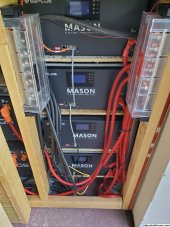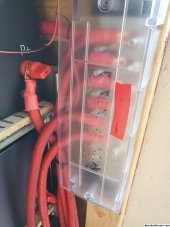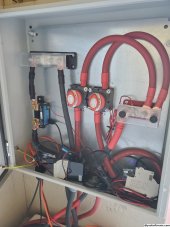I have asked for assistance previously on the DIY Solar Forum and gotten excellent help from Hedges and MurphyGuy. Their advice helped, and my installer was back in the area for a visit and got everything working. He has a lot of experience installing solar module setups, like the The Mall of Acadiana (Baton Rouge) and The University of Louisiana (Lafayette).
A recap of the system that I’m working with:
I currently have a professional installer solar panel system with:
24 solar modules (265W each),
2 SMA Sunny Boy 3000 inverters and
12 Tigo Optimizers.
With the help from my installer I’ve added:
24 additional solar modules (300W each),
2 SMA Sunny Boy SB6.0 1SP-US-40 inverters
2 SMA Sunny Island SI4548-US-10 inverters
4 48V Discover AES battery packs.
Each “battery unit” (from the data sheets provided by Discover Batteries) has:
Cell Modules - 16S 26P
Cell Chemistry - LiFePO4
Max Bulk Current - 130A dc
Bulk Voltage - 54.4V.
Battery wires - 2/0 gauge
Two of the “packs” are currently connected in parallel to create one true battery pack that has been working great for several months. There were several 1302 (Arc Flash) Error messages, but after recommendations from my installer I removed all of the Tigo Optimizers. No more Error 1302 messages.
The only occasional problem that I still have is with the Discover Lynk that allows the SMA SI4548 inverter to work with the Discover AES batteries. So far two of the battery units are connected together via Ethernet cables so that their individual BMSs can communicate with each other and the master inverter. If anything causes the Ethernet cables to shake or jiggle the Lynk shuts down due to what I think is a cheap connector. Welcome to southern Louisiana where we often have some hurricanes close to us each year. On each battery there is one Ethernet port that needs to have two Ethernet cables plugged into it. An adapter is plugged into that one Ethernet port on the battery and then two Ethernet cables can plug into the top of the adapter. I’ve taped the Ethernet cables to supports to reduce the chance of shaking.
The SB6.0 1SP-US-40 inverters do indeed work just fine without a grid connection when set up as Off-Grid 60Hertz.
That “battery pack” of two Discover AES batteries, however is too small for my overall use. It only has about 12.4 kwh calculated as (ah (130 for each battery) * estimated voltage (53V) divided by 1,000) * 90%. That is derated to a 90% value to put a bit less strain on the batteries. I don’t want to expect to use every kWh of power an an every day basis. The Discover batteries BMS shut down when the voltage gets down to 48V.
Several electric circuits at my home are still grid-tied, and need to be moved to our off-grid breaker box. None of the high energy circuits have been switched to off-grid. Those include the electric stove, clothes dryer, on demand tankless water heater, two unit mini split and an electric car charger (32A max charge rate set by the car charger).
Recently we bought two additional Discover AES battery packs, bringing the total Max Continuous Charge and Discharge rates up to 520Adc. That will be about 24.8 kWh of available power. Better, but perhaps still not really enough? Unfortunately Lithium Ion batteries are too expensive for me to add all at once. I should have bought all of the equipment from Signature Solar years ago. Oh well
A CHTAIXI DZ47Z-125A dc circuit breaker is on each side of the combined battery pack, between the battery pack and each of the SMA SI4548 inverters. All inverters are also connected to a breaker box with:
each SB6.0 - 30A breakers, and
each SI4548 - 50A breakers.
My current question is that Discover Battery Company recommends connecting that many of their batteries together using Bus Bars.
I have removed the top of one of the Discover AES batteries to replace a blown mega fuse, but I could not see how the individual batteries were arranged. The 16S 26P configuration does sound odd, but that is how it is listed on the specification sheet provided by the battery company.
A recap of the system that I’m working with:
I currently have a professional installer solar panel system with:
24 solar modules (265W each),
2 SMA Sunny Boy 3000 inverters and
12 Tigo Optimizers.
With the help from my installer I’ve added:
24 additional solar modules (300W each),
2 SMA Sunny Boy SB6.0 1SP-US-40 inverters
2 SMA Sunny Island SI4548-US-10 inverters
4 48V Discover AES battery packs.
Each “battery unit” (from the data sheets provided by Discover Batteries) has:
Cell Modules - 16S 26P
Cell Chemistry - LiFePO4
Max Bulk Current - 130A dc
Bulk Voltage - 54.4V.
Battery wires - 2/0 gauge
Two of the “packs” are currently connected in parallel to create one true battery pack that has been working great for several months. There were several 1302 (Arc Flash) Error messages, but after recommendations from my installer I removed all of the Tigo Optimizers. No more Error 1302 messages.
The only occasional problem that I still have is with the Discover Lynk that allows the SMA SI4548 inverter to work with the Discover AES batteries. So far two of the battery units are connected together via Ethernet cables so that their individual BMSs can communicate with each other and the master inverter. If anything causes the Ethernet cables to shake or jiggle the Lynk shuts down due to what I think is a cheap connector. Welcome to southern Louisiana where we often have some hurricanes close to us each year. On each battery there is one Ethernet port that needs to have two Ethernet cables plugged into it. An adapter is plugged into that one Ethernet port on the battery and then two Ethernet cables can plug into the top of the adapter. I’ve taped the Ethernet cables to supports to reduce the chance of shaking.
The SB6.0 1SP-US-40 inverters do indeed work just fine without a grid connection when set up as Off-Grid 60Hertz.
That “battery pack” of two Discover AES batteries, however is too small for my overall use. It only has about 12.4 kwh calculated as (ah (130 for each battery) * estimated voltage (53V) divided by 1,000) * 90%. That is derated to a 90% value to put a bit less strain on the batteries. I don’t want to expect to use every kWh of power an an every day basis. The Discover batteries BMS shut down when the voltage gets down to 48V.
Several electric circuits at my home are still grid-tied, and need to be moved to our off-grid breaker box. None of the high energy circuits have been switched to off-grid. Those include the electric stove, clothes dryer, on demand tankless water heater, two unit mini split and an electric car charger (32A max charge rate set by the car charger).
Recently we bought two additional Discover AES battery packs, bringing the total Max Continuous Charge and Discharge rates up to 520Adc. That will be about 24.8 kWh of available power. Better, but perhaps still not really enough? Unfortunately Lithium Ion batteries are too expensive for me to add all at once. I should have bought all of the equipment from Signature Solar years ago. Oh well
A CHTAIXI DZ47Z-125A dc circuit breaker is on each side of the combined battery pack, between the battery pack and each of the SMA SI4548 inverters. All inverters are also connected to a breaker box with:
each SB6.0 - 30A breakers, and
each SI4548 - 50A breakers.
My current question is that Discover Battery Company recommends connecting that many of their batteries together using Bus Bars.
- Do I need a dc fuse (or breaker) between each battery positive terminal and the Bus Bar, rather than just between the batteries and the SI4548 inverters?
- Can anyone recommend a good quality dc circuit breaker to replace the Chinese one that I have?
- Do I leave the neutral wire unfused?
I have removed the top of one of the Discover AES batteries to replace a blown mega fuse, but I could not see how the individual batteries were arranged. The 16S 26P configuration does sound odd, but that is how it is listed on the specification sheet provided by the battery company.





